Phase Lock Loops and
Frequency Synthesis
Phase Lock Loops and Frequency Synthesis V.F. Kroupa
2003 John Wiley & Sons, Ltd
ISBN: 0-470-84866-9
�
Phase Lock Loops and
Frequency Synthesis
Vˇenceslav F. Kroupa
Academy of Sciences of the Czech Republic, Prague
�
Copyright 2003
John Wiley & Sons Ltd, The Atrium, Southern Gate, Chichester,
West Sussex PO19 8SQ, England
Telephone (+44) 1243 779777
Email (for orders and customer service enquiries): cs-books@wiley.co.uk
Visit our Home Page on www.wileyeurope.com or www.wiley.com
All Rights Reserved. No part of this publication may be reproduced, stored in a retrieval system or
transmitted in any form or by any means, electronic, mechanical, photocopying, recording, scanning or
otherwise, except under the terms of the Copyright, Designs and Patents Act 1988 or under the terms of
a licence issued by the Copyright Licensing Agency Ltd, 90 Tottenham Court Road, London W1T 4LP,
UK, without the permission in writing of the Publisher. Requests to the Publisher should be addressed
to the Permissions Department, John Wiley & Sons Ltd, The Atrium, Southern Gate, Chichester, West
Sussex PO19 8SQ, England, or emailed to permreq@wiley.co.uk, or faxed to (+44) 1243 770620.
This publication is designed to provide accurate and authoritative information in regard to the subject
matter covered. It is sold on the understanding that the Publisher is not engaged in rendering
professional services. If professional advice or other expert assistance is required, the services of a
competent professional should be sought.
Other Wiley Editorial Offices
John Wiley & Sons Inc., 111 River Street, Hoboken, NJ 07030, USA
Jossey-Bass, 989 Market Street, San Francisco, CA 94103-1741, USA
Wiley-VCH Verlag GmbH, Boschstr. 12, D-69469 Weinheim, Germany
John Wiley & Sons Australia Ltd, 33 Park Road, Milton, Queensland 4064, Australia
John Wiley & Sons (Asia) Pte Ltd, 2 Clementi Loop #02-01, Jin Xing Distripark, Singapore 129809
John Wiley & Sons Canada Ltd, 22 Worcester Road, Etobicoke, Ontario, Canada M9W 1L1
Wiley also publishes its books in a variety of electronic formats. Some content that appears
in print may not be available in electronic books.
British Library Cataloguing in Publication Data
A catalogue record for this book is available from the British Library
ISBN 0-470-84866-9
Typeset in 10.5/13pt Times by Laserwords Private Limited, Chennai, India
Printed and bound in Great Britain by TJ International, Padstow, Cornwall
This book is printed on acid-free paper responsibly manufactured from sustainable forestry
in which at least two trees are planted for each one used for paper production.
�
To my wife Magda for her encouragement in starting and finishing this work
�
Contents
Preface
1 Basic Equations of the PLLs
1.1 Introduction
1.2 Basic Equations of the PLLs
1.3 Solution of the Basic PLL Equation in the Time Domain
1.3.1 Solution in the Closed Form
1.3.2 Linearized Solution
1.4 Solution of Basic PLL Equations in the Frequency Domain
1.5 Order and Type of PLLs
1.5.1 Order of PLLs
1.5.2 Type of PLLs
1.5.3 Steady State Errors
1.6 Block Diagram Algebra
References
2 PLLs of the First and Second Order
2.1 PLLs of the First Order
2.2 PLLs of the Second Order
2.2.1 A Simple RC Filter
2.2.2 Phase Lag-lead RRC or RCC Filter
2.3 PLLs of the Second Order of Type 2
2.3.1 PLLs of the Second Order of Type 2 with Voltage Output PD
2.3.2 PLLs of the Second Order of Type 2 with Current Output Phase
Detector
2.4 Second-order PLLs with Frequency Dividers in the Feedback Path
References
3 PLLs of the Third and Higher Orders
3.1 General Open-loop Transfer Function G(s)
3.1.1 Additional RC Section
3.1.2 Two RC Sections
xiii
1
1
1
4
4
5
6
7
8
9
9
10
12
13
13
15
15
17
20
21
23
26
27
29
30
30
30
�
viii
CONTENTS
3.1.3 Active Second-order Low-pass Filter
3.1.4 Twin-T RC Filter
3.1.5 PLLs with a Selective Filter in the Feedback Path
3.1.6 Time Delays in PLLs
3.2 Higher-order Type 2 PLLs
3.2.1 Third-order Loops: Lag-lead Filter with Additional RC Section
3.2.2 Third-order Loop: Second-order Lag Filter Plus RC Section
3.2.3 Fourth-order Loops
3.2.4 Fifth-order Loops
3.3 PLLs with Transmission Blocks in the Feedback Path
3.3.1 Divider in the Feedback Path
3.3.2 IF Filter in the Feedback Path
3.3.3 IF Filter and Divider in the Feedback Path
3.4 Sampled Higher-order Loops
3.4.1 Third-order Loops with the Current Output Phase Detector
3.5 Higher-order Loops of Type 3
3.6 Computer Design of a Higher-order PLL
References
4 Stability of the PLL Systems
4.1 Hurwitz Criterion of Stability
4.2 Computation of the Roots of the Polynomial P (s)
4.3 Expansion of the Function 1/[1 + G(s)] into a Sum of Simple Fractions
4.3.1 Polynomial S(s) Contains Simple Roots Only
4.3.2 Polynomial S(s) Contains a Pair of Complex Roots
4.3.3 Polynomial S(s) Contains Multiple-order Roots
4.4 The Root-locus Method
4.5 Frequency Analysis of the Transfer Functions – Bode Plots
4.5.1 Bode Plots
4.5.2 Polar Diagrams
4.6 Nyquist Criterion of Stability
4.7 The Effective Damping Factor
4.8 Appendix
References
5 Tracking
5.1 Transients in PLLs
5.1.1 Transients in First-order PLLs
5.1.2 Transients in Second-order PLLs
5.1.3 Transients in Higher-order Loops
5.2 Periodic Changes
5.2.1 Phase Modulation of the Input Signal
5.2.2 Frequency Modulation of the Input Signal
32
33
35
38
41
41
43
46
49
55
55
56
56
56
56
59
60
63
65
66
68
69
69
69
70
70
73
74
81
83
88
91
92
93
93
94
94
101
101
104
104
�
CONTENTS
ix
5.3 Discrete Spurious Signals
5.3.1 Small Discrete Spurious Signals at the Input
5.3.2 Small Spurious Signals at the Output of the Phase Detector
5.3.3 Small Spurious Signals at the Output of the PLLs
References
6 Working Ranges of PLLs
6.1 Hold-in Range
6.1.1 Phase Detector with the Sine Wave Output
6.1.2 The PD with Triangular Output
6.1.3 The PD with a Sawtooth Wave Output
6.1.4 Sequential Phase Frequency Detectors
6.2 The Pull-in Range
6.2.1 PLLs of the First Order
6.2.2 PLLs of the Second Order
6.3 Lock-in Range
6.3.1 PLLs of the First Order
6.3.2 PLLs of the Second Order
6.4 Pull-out Frequency
6.5 Higher-order PLLs and Difficulties with Locking
6.5.1 False Locking
6.5.2 Locking on Sidebands
6.5.3 Locking on Harmonics
6.5.4 Locking on Mirror Frequencies
References
7 Acquisition of PLLs
7.1 The Pull-in Time
7.1.1 The Pull-in Time of a PLL with Sine Wave PD
7.1.2 The Pull-in Time of a PLL with Sawtooth Wave PD
7.1.3 The Pull-in Time of a PLL with Triangular Wave PD
7.2 The Lock-in Time
7.3 Aided Acquisition
7.3.1 Pretuning of the VCO
7.3.2 Forced Tuning of the VCO
7.3.3 Assistance of the Frequency Discriminator
7.3.4 Increasing the PLL Bandwidth
7.4 Time to Unlock
References
8 Basic Blocks of PLLs
8.1 Filters with Operational Amplifiers
105
105
107
109
110
111
111
112
112
112
113
113
117
118
125
127
128
130
132
133
134
134
135
136
137
137
138
140
141
141
142
142
142
143
145
148
148
149
149
�
x
CONTENTS
8.2 Integrators
8.2.1 Active Integrators with Operation Amplifiers
8.2.2 Passive Integrators
8.3 Mixers
8.3.1 Multiplicative Mixers
8.3.2 Switching Mixers
8.3.3 Ring Modulators
8.4 Phase Detectors
8.4.1 A Simple Switch
8.4.2 Ring Modulators
8.4.3 Sampling Phase Detectors
8.4.4 Digital Phase Detectors
8.5 Frequency Dividers
8.5.1 Regenerative Frequency Dividers
8.5.2 Digital Frequency Dividers
8.6 Digital Circuits
8.6.1 Gates – the Logic Levels and Symbols
8.6.2 Flip-flops
References
9 Noise and Time Jitter
9.1 Introduction
9.2 Types of Noise
9.2.1 White Noise
9.2.2 Flicker or 1/f Noise
9.2.3 Noise 1/f 2
9.2.4 Piece-wise Approximations of Noise Characteristics
9.3 Mathematical Theory of Noise
9.3.1 Frequency Domain
9.3.2 Time Domain
9.3.3 Conversion Between Frequency and Time
Domain Measures
9.3.4 Phase and Time Jitter
9.3.5 Small and Band-limited Perturbations of Sinusoidal Signals
9.4 Component Noises
9.4.1 Amplifiers
9.4.2 Frequency Dividers
9.4.3 Phase Detectors
9.4.4 Noises Associated with Loop Filters
9.4.5 Oscillators
9.4.6 Oscillator Properties
9.4.7 Phase Noise in PLLs
9.4.8 Application of PLLs for Noise Measurement
152
152
152
152
153
155
156
158
158
158
160
164
172
172
173
180
181
183
187
189
189
189
190
194
195
196
197
197
199
199
200
203
205
205
206
208
208
211
215
220
223
�
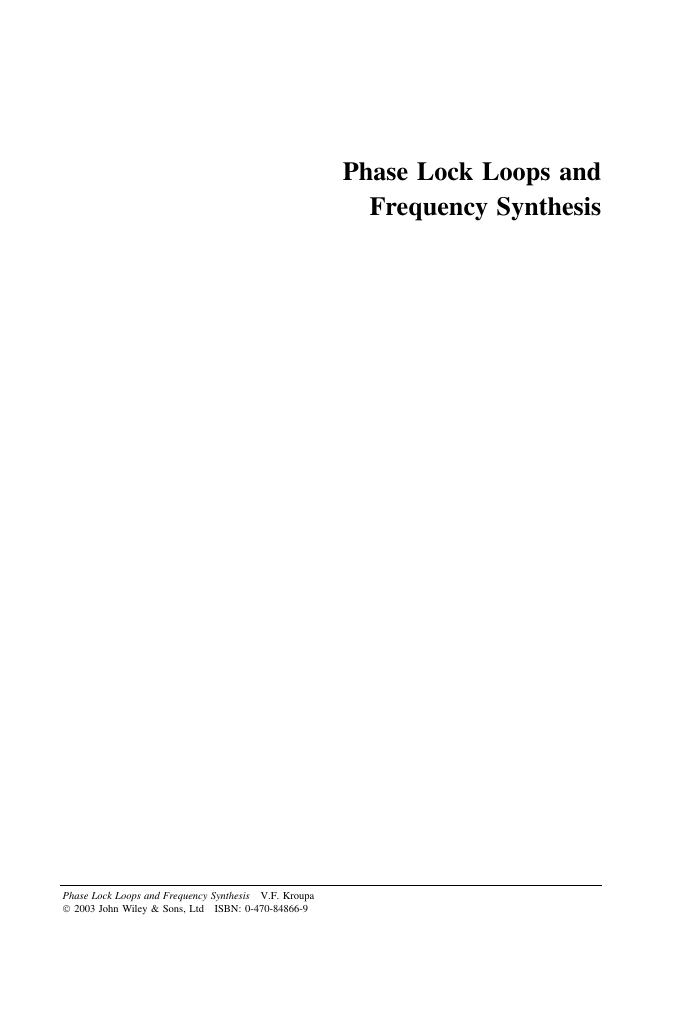
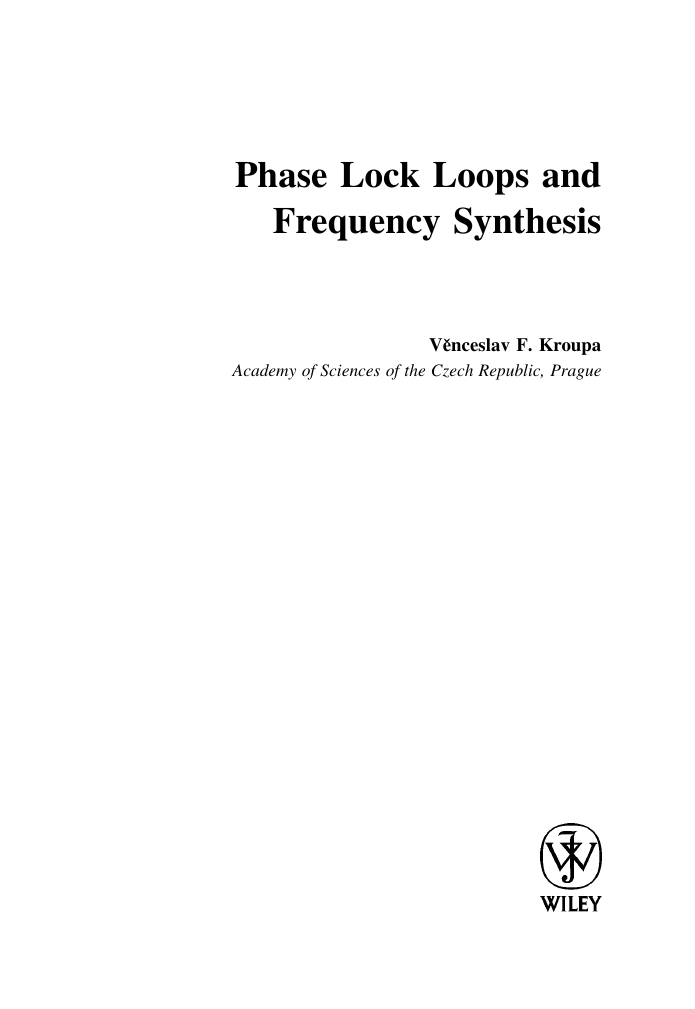
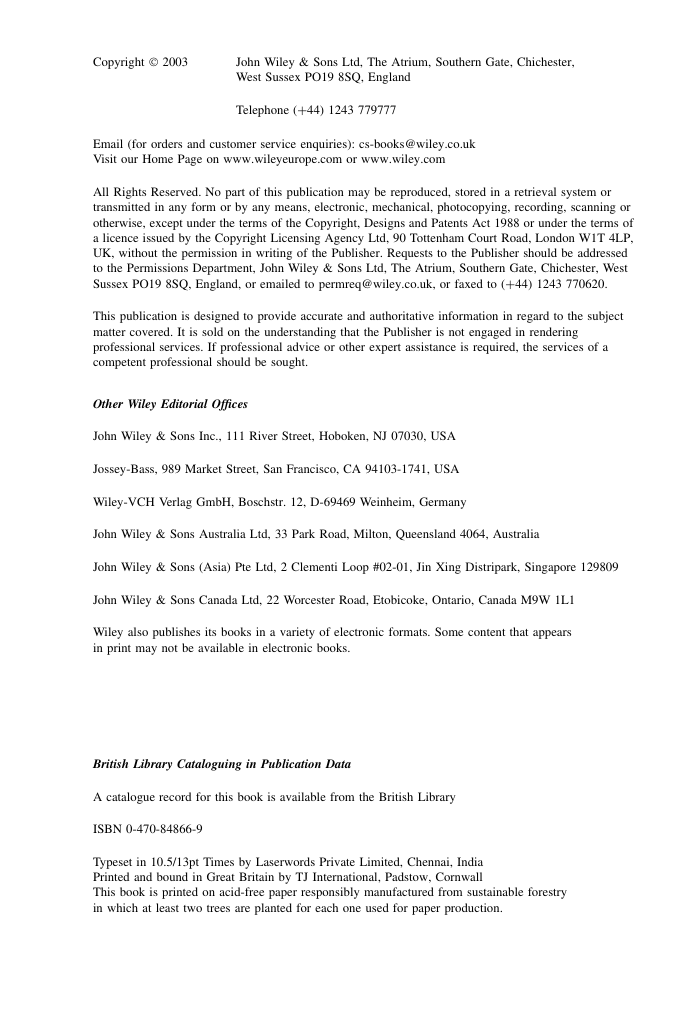

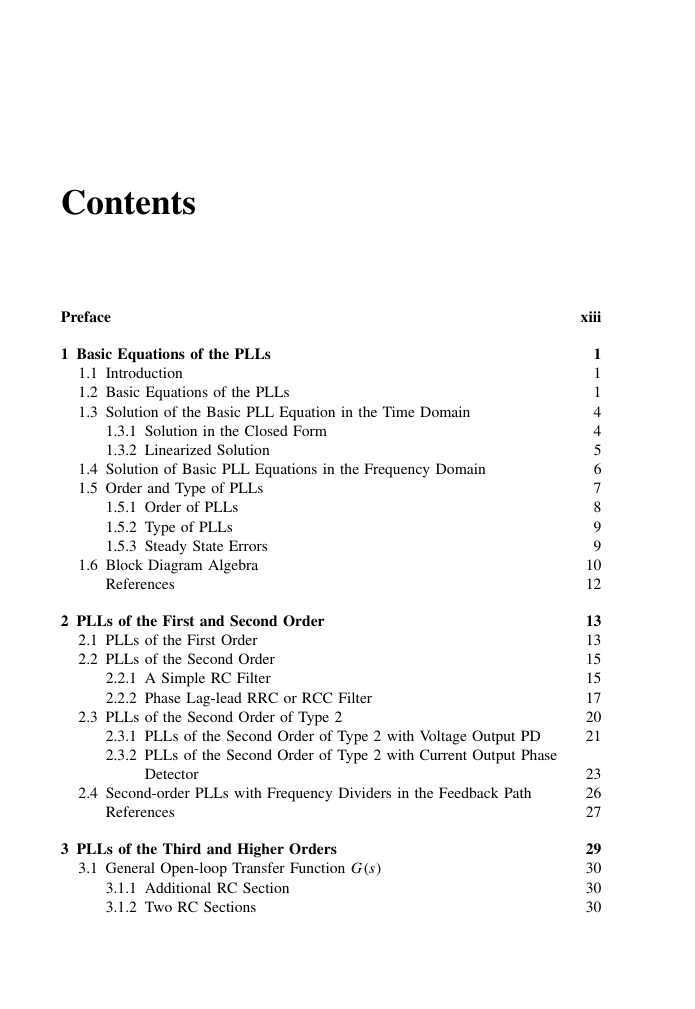

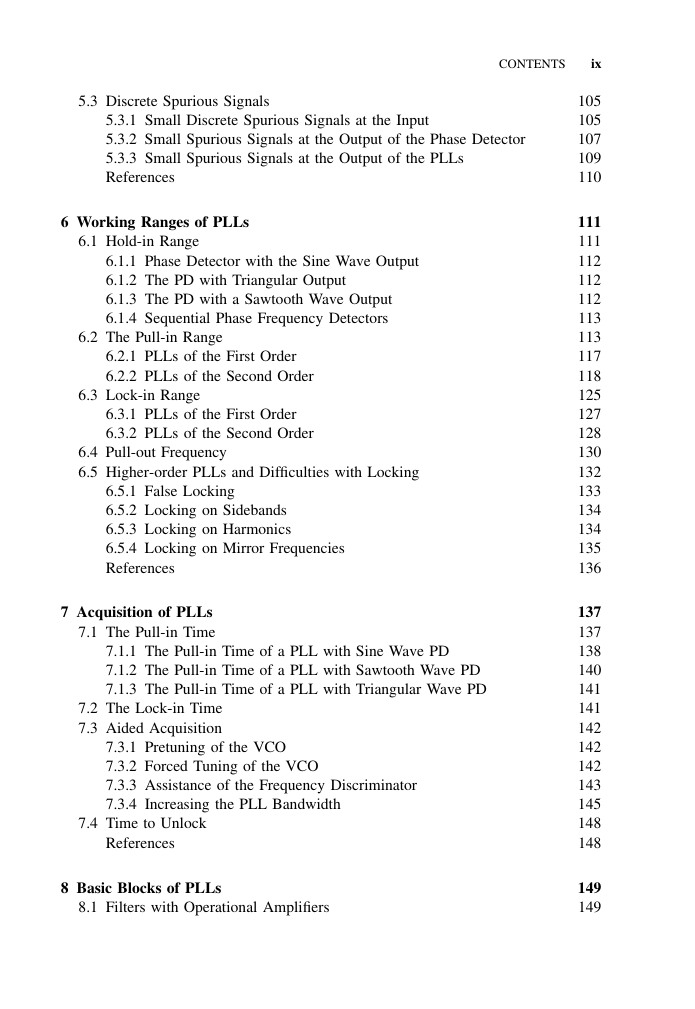
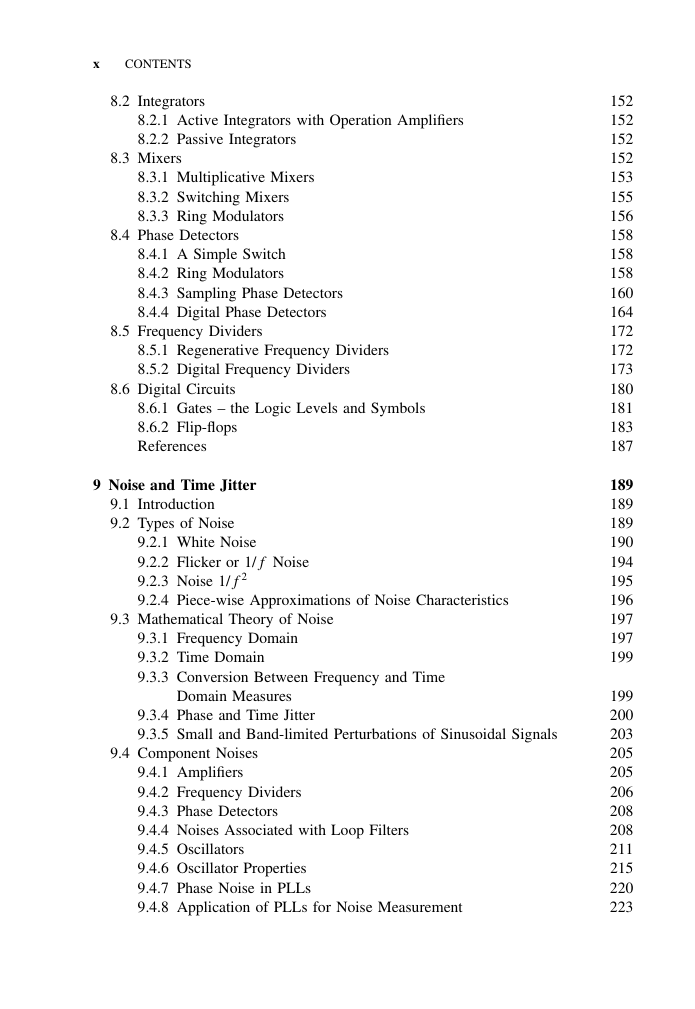








 2023年江西萍乡中考道德与法治真题及答案.doc
2023年江西萍乡中考道德与法治真题及答案.doc 2012年重庆南川中考生物真题及答案.doc
2012年重庆南川中考生物真题及答案.doc 2013年江西师范大学地理学综合及文艺理论基础考研真题.doc
2013年江西师范大学地理学综合及文艺理论基础考研真题.doc 2020年四川甘孜小升初语文真题及答案I卷.doc
2020年四川甘孜小升初语文真题及答案I卷.doc 2020年注册岩土工程师专业基础考试真题及答案.doc
2020年注册岩土工程师专业基础考试真题及答案.doc 2023-2024学年福建省厦门市九年级上学期数学月考试题及答案.doc
2023-2024学年福建省厦门市九年级上学期数学月考试题及答案.doc 2021-2022学年辽宁省沈阳市大东区九年级上学期语文期末试题及答案.doc
2021-2022学年辽宁省沈阳市大东区九年级上学期语文期末试题及答案.doc 2022-2023学年北京东城区初三第一学期物理期末试卷及答案.doc
2022-2023学年北京东城区初三第一学期物理期末试卷及答案.doc 2018上半年江西教师资格初中地理学科知识与教学能力真题及答案.doc
2018上半年江西教师资格初中地理学科知识与教学能力真题及答案.doc 2012年河北国家公务员申论考试真题及答案-省级.doc
2012年河北国家公务员申论考试真题及答案-省级.doc 2020-2021学年江苏省扬州市江都区邵樊片九年级上学期数学第一次质量检测试题及答案.doc
2020-2021学年江苏省扬州市江都区邵樊片九年级上学期数学第一次质量检测试题及答案.doc 2022下半年黑龙江教师资格证中学综合素质真题及答案.doc
2022下半年黑龙江教师资格证中学综合素质真题及答案.doc